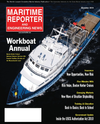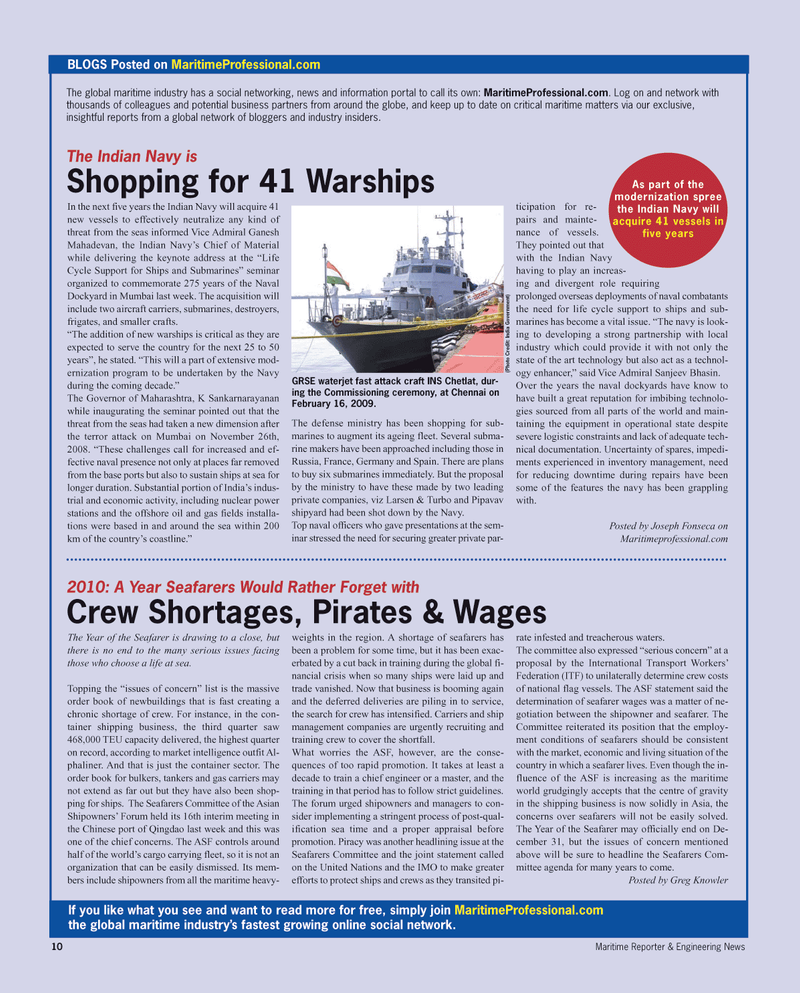
Page 10: of Maritime Reporter Magazine (November 2010)
Workboat Annual
Read this page in Pdf, Flash or Html5 edition of November 2010 Maritime Reporter Magazine
10 Maritime Reporter & Engineering News
The global maritime industry has a social networking, news and information portal to call its own: MaritimeProfessional.com. Log on and network with thousands of colleagues and potential business partners from around the globe, and keep up to date on critical maritime matters via our exclusive, insightful reports from a global network of bloggers and industry insiders.
In the next five years the Indian Navy will acquire 41 new vessels to effectively neutralize any kind of threat from the seas informed Vice Admiral Ganesh
Mahadevan, the Indian Navy’s Chief of Material while delivering the keynote address at the “Life
Cycle Support for Ships and Submarines” seminar organized to commemorate 275 years of the Naval
Dockyard in Mumbai last week. The acquisition will include two aircraft carriers, submarines, destroyers, frigates, and smaller crafts. “The addition of new warships is critical as they are expected to serve the country for the next 25 to 50 years”, he stated. “This will a part of extensive mod- ernization program to be undertaken by the Navy during the coming decade.”
The Governor of Maharashtra, K Sankarnarayanan while inaugurating the seminar pointed out that the threat from the seas had taken a new dimension after the terror attack on Mumbai on November 26th, 2008. “These challenges call for increased and ef- fective naval presence not only at places far removed from the base ports but also to sustain ships at sea for longer duration. Substantial portion of India’s indus- trial and economic activity, including nuclear power stations and the offshore oil and gas fields installa- tions were based in and around the sea within 200 km of the country’s coastline.”
The defense ministry has been shopping for sub- marines to augment its ageing fleet. Several subma- rine makers have been approached including those in
Russia, France, Germany and Spain. There are plans to buy six submarines immediately. But the proposal by the ministry to have these made by two leading private companies, viz Larsen & Turbo and Pipavav shipyard had been shot down by the Navy.
Top naval officers who gave presentations at the sem- inar stressed the need for securing greater private par- ticipation for re- pairs and mainte- nance of vessels.
They pointed out that with the Indian Navy having to play an increas- ing and divergent role requiring prolonged overseas deployments of naval combatants the need for life cycle support to ships and sub- marines has become a vital issue. “The navy is look- ing to developing a strong partnership with local industry which could provide it with not only the state of the art technology but also act as a technol- ogy enhancer,” said Vice Admiral Sanjeev Bhasin.
Over the years the naval dockyards have know to have built a great reputation for imbibing technolo- gies sourced from all parts of the world and main- taining the equipment in operational state despite severe logistic constraints and lack of adequate tech- nical documentation. Uncertainty of spares, impedi- ments experienced in inventory management, need for reducing downtime during repairs have been some of the features the navy has been grappling with.
Posted by Joseph Fonseca on
Maritimeprofessional.com
If you like what you see and want to read more for free, simply join MaritimeProfessional.com the global maritime industry’s fastest growing online social network.
BLOGS Posted on MaritimeProfessional.com
As part of the modernization spree the Indian Navy will acquire 41 vessels in five years
The Indian Navy is
Shopping for 41 Warships
GRSE waterjet fast attack craft INS Chetlat, dur- ing the Commissioning ceremony, at Chennai on
February 16, 2009. (Photo Cr edit: India Government)
The Year of the Seafarer is drawing to a close, but there is no end to the many serious issues facing those who choose a life at sea.
Topping the “issues of concern” list is the massive order book of newbuildings that is fast creating a chronic shortage of crew. For instance, in the con- tainer shipping business, the third quarter saw 468,000 TEU capacity delivered, the highest quarter on record, according to market intelligence outfit Al- phaliner. And that is just the container sector. The order book for bulkers, tankers and gas carriers may not extend as far out but they have also been shop- ping for ships. The Seafarers Committee of the Asian
Shipowners’ Forum held its 16th interim meeting in the Chinese port of Qingdao last week and this was one of the chief concerns. The ASF controls around half of the world’s cargo carrying fleet, so it is not an organization that can be easily dismissed. Its mem- bers include shipowners from all the maritime heavy- weights in the region. A shortage of seafarers has been a problem for some time, but it has been exac- erbated by a cut back in training during the global fi- nancial crisis when so many ships were laid up and trade vanished. Now that business is booming again and the deferred deliveries are piling in to service, the search for crew has intensified. Carriers and ship management companies are urgently recruiting and training crew to cover the shortfall.
What worries the ASF, however, are the conse- quences of too rapid promotion. It takes at least a decade to train a chief engineer or a master, and the training in that period has to follow strict guidelines.
The forum urged shipowners and managers to con- sider implementing a stringent process of post-qual- ification sea time and a proper appraisal before promotion. Piracy was another headlining issue at the
Seafarers Committee and the joint statement called on the United Nations and the IMO to make greater efforts to protect ships and crews as they transited pi- rate infested and treacherous waters.
The committee also expressed “serious concern” at a proposal by the International Transport Workers’
Federation (ITF) to unilaterally determine crew costs of national flag vessels. The ASF statement said the determination of seafarer wages was a matter of ne- gotiation between the shipowner and seafarer. The
Committee reiterated its position that the employ- ment conditions of seafarers should be consistent with the market, economic and living situation of the country in which a seafarer lives. Even though the in- fluence of the ASF is increasing as the maritime world grudgingly accepts that the centre of gravity in the shipping business is now solidly in Asia, the concerns over seafarers will not be easily solved.
The Year of the Seafarer may officially end on De- cember 31, but the issues of concern mentioned above will be sure to headline the Seafarers Com- mittee agenda for many years to come.
Posted by Greg Knowler 2010: A Year Seafarers Would Rather Forget with
Crew Shortages, Pirates & Wages

 9
9

 11
11
